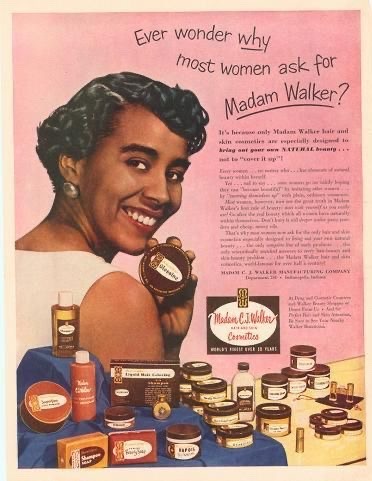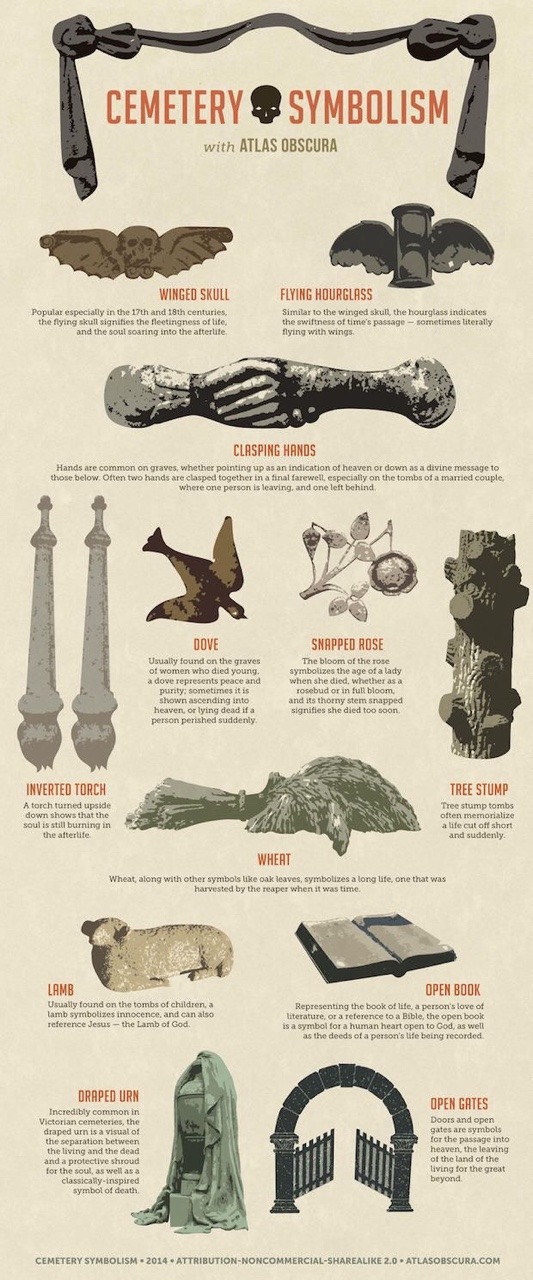Text

Troy Stix (Frances Troy Stix) was a dress designer who worked for Herbert Sondheim's apparel company from the 1940s through the 1960s. Herbert was legendary Broadway musical composer Stephen Sondheim's father. The above dress Troy designed for Sondheim was featured in an issue of Vogue magazine in 1945.
Before joining Sondheim's firm, Troy was working for department store Lord & Taylor. One of the dresses she designed for them was featured in Life Magazine in their September 1940 story about New York Fashion Week that year; Fashion Week was attended by then mayor Fiorello LaGuardia (who also rests at Woodlawn:)

She married lawyer John E. Connelly Jr. Their duplex apartment on Manhattan’s East Side was featured in House & Garden magazine's February 1956 issue; Troy's photo from that article is below as well as a photo of her bathroom, with monogrammed towels, and linen tablecloths as wallpaper!


Troy died in 1972 at age 66; she is entombed in Woodlawn.

5 notes
·
View notes
Text
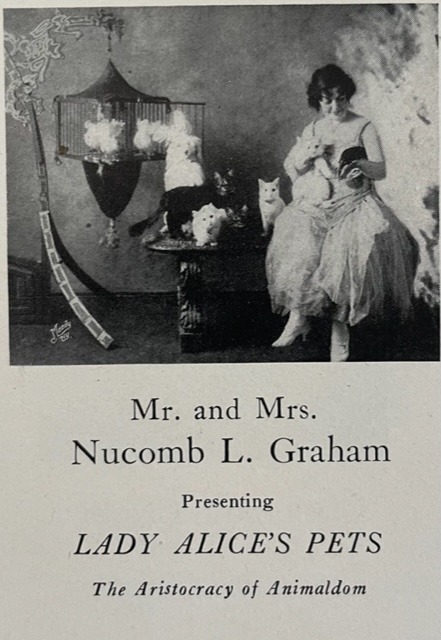
1924 ad in the N.V.A. benefit annual (N.V.A. - National Vaudeville Artists.)
Alice Graham's animal act was so extraordinary to Gypsy Rose Lee and her actress sister June Havoc (who as "Baby June" was on the same vaudeville circuit as Lady Alice at one time) that they both mentioned Alice in their autobiographies!
Mr. and Mrs. Graham rest together in Woodlawn Cemetery in the Bronx.
2 notes
·
View notes
Text
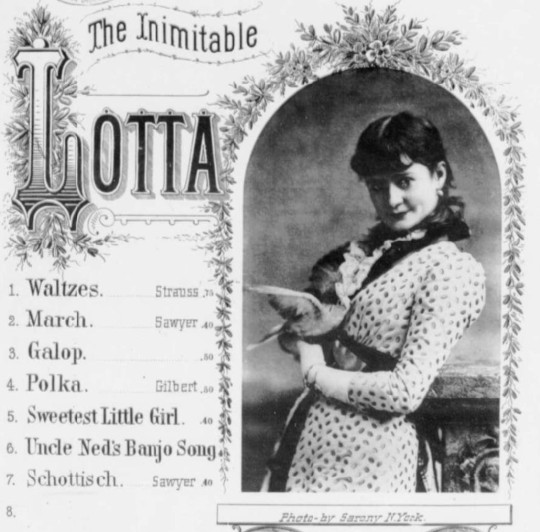
(Songsheet via LOC.gov)
Lotta Crabtree was one of America’s first child stars and one of those rare celebrities widely referred to with just one name; she was known across the country as simply “LOTTA.” She rests in Woodlawn’s Juniper section along with her brother John, her Aunt Charlotte (for whom she was named) and her devoted mother, Mary Ann Crabtree. Lotta’s stone reads:
Lotta M. Crabtree /September 25, 1924/Beloved Actress/Founder of Noble Charities

Lotta began her journey to stardom in the gold mining camps of California in the 1850s. She was born in New York in 1847 but her English immigrant father John Crabtree left his Manhattan bookshop in 1851 to follow the rush for gold on the west coast, and young Lotta and mother Mary Ann followed after a couple of years.
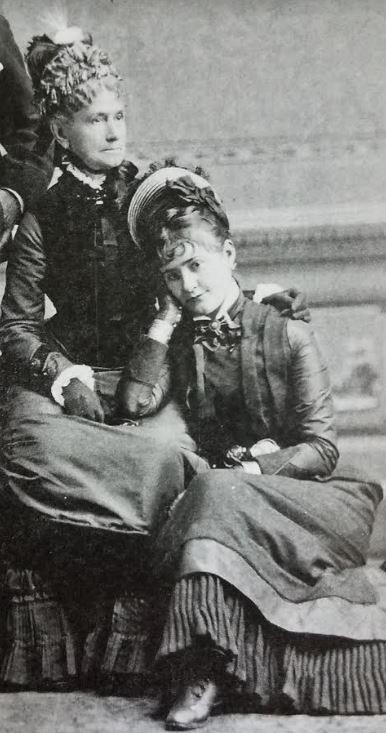
(Lotta and mother Mary Ann Crabtree around 1879; photo from book Lotta Crabtree: Gold Rush Fairy Star by Lois V. Harris)
Mary Ann Livesey Crabtree was herself an immigrant from England. She was truly a controlling “stage mother/Momager” who could’ve given Gypsy Rose Lee’s Mama Rose a run for her money, but I have to admire her survivor’s spirit and financial savvy; it was thanks to her wise management of her daughter’s earnings that Lotta eventually became the richest actress in America.
In California, John Crabtree never made a dime off the gold mines and Mary Ann was stuck running a boarding house for the miners so her family could eke out a living. John seemed to hang around just long enough to get Mary Ann pregnant again and then take off when he found “new opportunities” (which inevitably led to nothing.) Mary Ann had two more children by him, both sons, before their eventual final separation.
While Mary Ann was keeping her family going running the boarding house, little Lotta befriended one of their neighbors, Lola Montez, a saucy celebrity known for her racy dances.
Lola taught Lotta to dance, and she soon realized Lotta was a natural. Lotta laughed when she danced, a habit that stayed with her and was part of the perky personality that would charm audiences all over the States for decades to come. Lola also taught Lotta to ride a horse, which would become a life-long passion (Lotta eventually owned winning race horses for a time.)
Entertainers came frequently to the mining camps to perform for the men panning for gold, and when the miners approved, the players were sometimes rewarded with gold nuggets thrown up on the makeshift stages. Mary Ann Crabtree saw an opportunity and encouraged her tiny daughter to start performing for the miners.
Lotta learned the banjo (one of the first female entertainers to do so) as well as different songs and dances from the entertainers who came to the camps, and Mary Ann herself learned to play the triangle and to do some impersonations; the two eventually joined a troupe and started traveling around California to perform at various mines. Lotta wasn’t even 10 years old when she and Mary Ann made these rough journeys by horse, mule and stagecoach over dangerous terrain, but they persevered and Lotta began thriving on the makeshift stages. The miners adored her.

(Lotta as a child, photo from San Francisco Public Library archives: https://sfplamr.blogspot.com/2008/08/san-francisco-theatre-research.html)
Lotta’s popularity in the mines led to stage work in San Francisco and eventually to New York and many main cities in between. Lotta was never a serious actress and critics frequently panned the shows she was in, but people loved her quick humor and amusing dances; her personality leaped from the stage. She loved playing roles where she could dress as a boy or do multiple characters in a show.
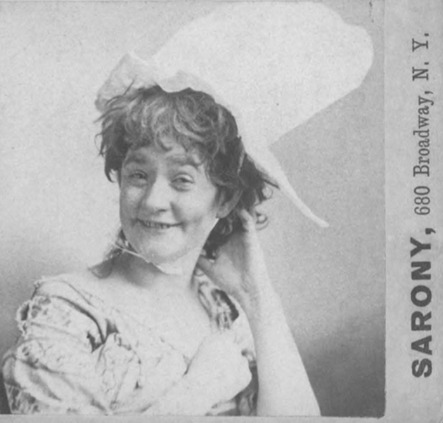
(Lotta as The Marchioness in “Little Nell & The Marchioness”, a favorite role of hers)

(Lotta in “Cranks”; photo from https://www.broadway.cas.sc.edu/content/lotta-crabtree-cranks)
By all accounts Lotta was well loved by both audiences and other entertainers alike, though she never married and Mary Ann remained her closest companion until Mary Ann’s death at age 84. There was speculation that Mary Ann kept any possible suitors away from Lotta but it’s really impossible to know if Lotta remained unmarried by choice or if she truly was stuck under Mary Ann’s thumb. There were apparently many men romantically interested in Lotta, some seriously and some for possible financial gain (she was sued at least once for money by a “husband” who was proven to be a phony just out for a payout.) Lotta had one persistent stalker who bombarded her with letters and followed her around the country until she finally had him arrested. He was released and returned to his native San Francisco where he eventually committed suicide by drowning.
Lotta remained particularly popular with the California miners who recalled her performances from the gold rush days and beloved by “newsies” for her generous spirit, as mentioned in this 1858 article from the New York Times:

(from the New York Times, September 1858)
Lotta retired from performing in her 40s after suffering an injury on stage that took months to heal. She decided to get out permanently while she was still popular; she then enjoyed several decades of rest from her long years of constant touring and passed away in 1925, aged 76. She must have been gratified to live to see American women get the right to vote; she had told reporters who asked that she was for women’s suffrage.
Lotta is mainly remembered now for the still-existent fountain she funded in San Francisco in 1875 to provide water for horses and dogs. Lotta’s Fountain in San Francisco survived the Great Earthquake of 1906 and it became a meeting point for survivors of the disaster. Each year on the anniversary of the earthquake, San Francisco still holds a commemorative ceremony at the fountain.
Lotta also left an estate of almost $4 million dollars to various charitable foundations in her will, providing for veterans of World War I, newly released prisoners, farming students and homeless animals, among others. Grants are given to this day out of her estate.
More bio info can be found on the Wiki page on Lotta: https://en.wikipedia.org/wiki/Lotta_Crabtree
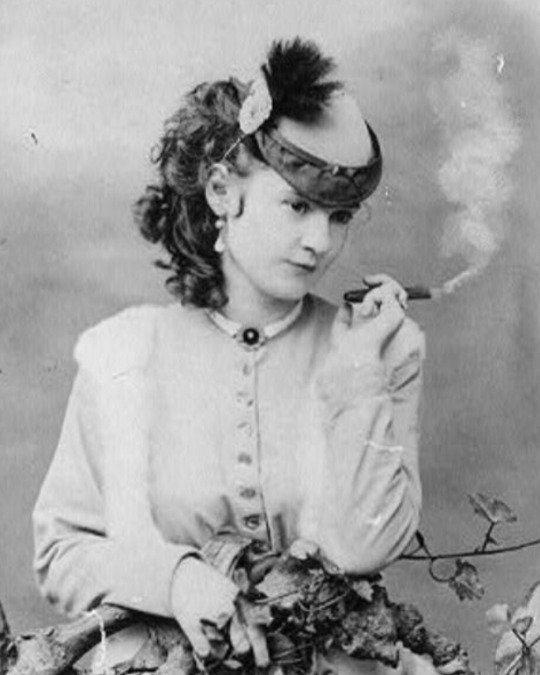
4 notes
·
View notes
Photo
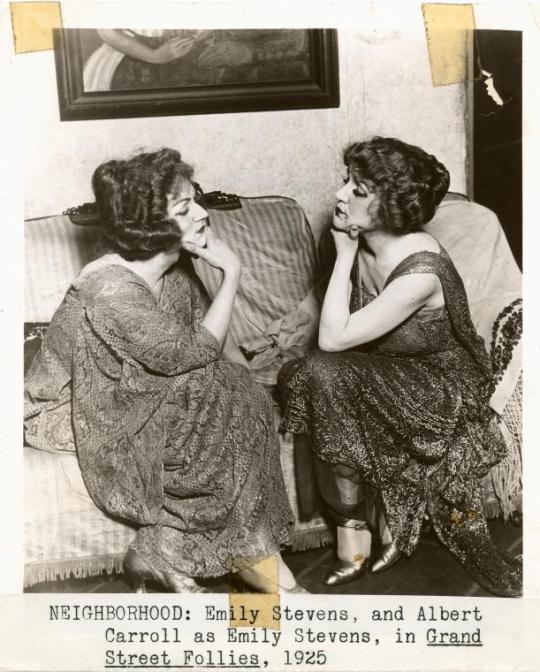
The above photo comes via New York Public Library Digital Collections and features an actress who rests in Woodlawn Cemetery, Emily Stevens.
https://digitalcollections.nypl.org/items/a1615a3c-295b-fd0e-e040-e00a180636c0
The Neighborhood Playhouse in Manhattan usually presented dramas back in the 1920s, but for several years they put on revues in the summer months that parodied what was going on in theatre at the time (decades before “Forbidden Broadway.”) Emily Stevens was a popular theatre actress (who would go onto silent films;) she was imitated by actor Albert Carroll in the Playhouse’s “Grand Street Follies” in 1925. Looks like Emily had a good sense of humor about it! The Neighborhood Playhouse was co-founded by Irene Lewisohn who also rests in Woodlawn Cemetery (she also appeared in the 1925 “Grand Street Follies”;) she will be the topic of a future post.
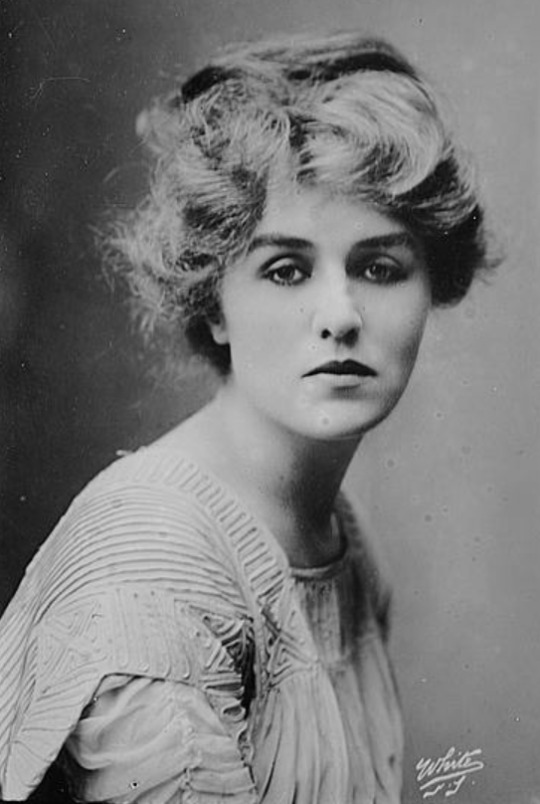
(above photo via Library of Congress)
Writer Anita Loos described Emily in her book Kiss Hollywood Good-By as “a full-blown, red-headed beauty.” She appeared in 15 silent films and many plays over the course of 25 years, including the title role in Ibsen's "Hedda Gabler" on Broadway in 1926. Actress Minnie Maddern Fiske was her cousin; Fiske came from Chicago to attend Emily’s funeral. Her parents were theatrical manager Robert E. Stevens and actress Emma Maddern.
Emily died in 1928 at her apartment at 50 W. 67th Street in Manhattan after an apparent sedative overdose which led to pneumonia; she was 54 years old.
#emily stevens#neighborhood playhouse#broadway#bronx#Woodlawn Cemetery#albert carroll#forbidden broadway
2 notes
·
View notes
Photo

Dorothy Parker’s monument at Woodlawn Cemetery in the Bronx. Mrs. Parker’s journey to Woodlawn was a long one, lasting decades! You can read all about it (and lots more about the woman and her work) at the official site for Dorothy Parker:
https://dorothyparker.com/
4 notes
·
View notes
Photo
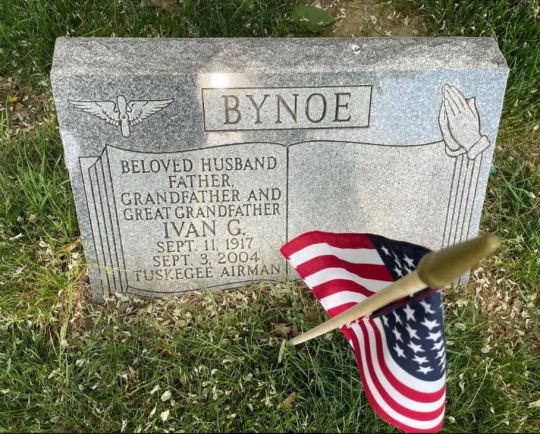
Woodlawn Cemetery has continued its annual ritual of flagging each military veteran’s grave around the Memorial Day holiday to honor them for their service.
One of the graves I flagged for them was for Ivan G. Bynoe, who was a Tuskegee Airman during WWII! It’s good to see by the engraving on his stone that he survived the war and was a great-grandfather when he passed away.
I found a photo of him in uniform dated May 1944 on the Getty Images website; you can see it here:
https://www.gettyimages.com/detail/news-photo/ivan-bynoe-head-and-shoulders-portrait-taken-during-his-news-photo/486796719
11 notes
·
View notes
Note
I can't believe I stumbled across this post on I. Frank Nowicki, just a little more than a month after you posted it. Frank was my great uncle. I was too young to remember much about him, but always heard the family story of how he went back into the burning house to save his violin. Although the violin was found with him, it disappeared afterward, and no one in the family has ever been able to locate it. Thanks for this wonderful post, which included some information that was new to me!
Thank you so much; I’m glad I was able to give you some new info about your great-uncle, his story is a very moving one.
4 notes
·
View notes
Text

The above photograph shows violinist/musical director Ignace Frank Nowicki as a teenager in his 1917 yearbook entry from when he attended the New England Conservatory of Music. Nowicki rests with his parents in Woodlawn’s Rhododendron plot.
Ignace Nowicki (who sometimes went by the names I. Frank Nowicki or Frank Nowicki) wasn’t an “important” person in the music industry but he stands out to me because of his deep passion for his craft—he not only lived for music, he died for it.
In 1967 he was 71 years old and living in an apartment on the 2nd floor of a house on Long Island when a fire broke out there. A neighbor later told a newspaper reporter that he saw Mr. Nowicki leaving the house dragging a burning piece of furniture with him. If he’d remained outside he would have most likely survived the fire, but apparently Nowicki went back into the house specifically to retrieve his violin. He was found dead inside his apartment by firefighters, his violin by his side.
The son of Polish immigrants who lived in the Bronx, Nowicki began his musical training at age 8. As World War I was raging in 1918, he performed at a wartime bond drive presented by Boston department store Jordan Marsh:
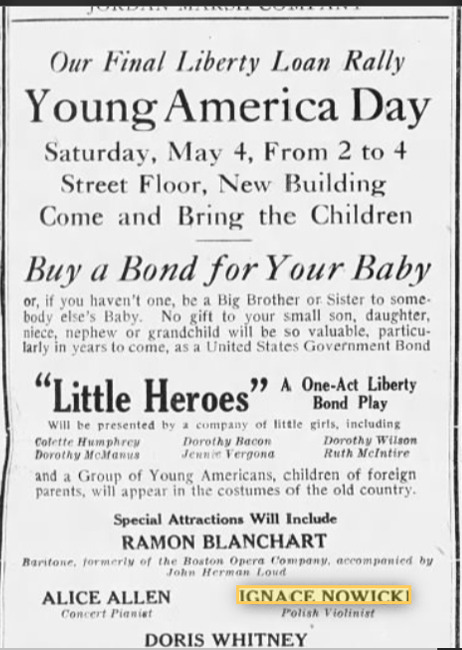
(ad from the Boston Globe, May 3, 1918)
Early in his career Nowicki played first violin in the Victor Herbert Symphony Orchestra. By the mid 1920s, he was part of S.L. “Roxy” Rothafel’s Capital Theatre Orchestra; they were heard on the radio every Sunday night. According to Ross Melnick’s biography of Roxy Rothafel, the show was wildly popular and thousands of fan letters were sent to Rothafel. (https://en.wikipedia.org/wiki/Samuel_Roxy_Rothafel)

Nowicki must have had a good reputation with Rothafel’s organization; after playing with the Capital Theatre Gang, Nowicki was appointed as one of the Roxy Theatre conductors in 1931 and then associate conductor at Rothafel’s Radio City Music Hall in the late 1930s/early 1940s.
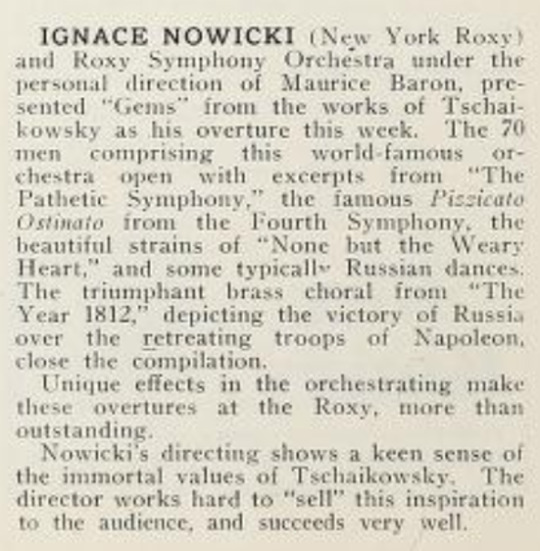
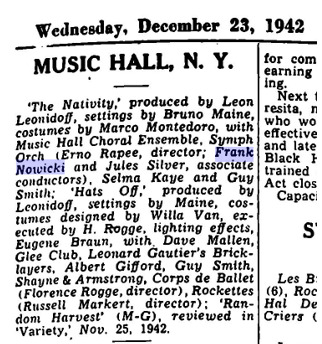
After that, Nowicki turned to Broadway, becoming assistant conductor or musical director for the classic 1940s/1950s musicals “Bells Are Ringing”, “South Pacific” and “On The Town.” Papers found by Nassau County Police in Nowicki’s home after his death showed that he had also been involved with “Show Boat” and “Gypsy” and played with the tour companies of various shows.
Nowicki never retired—neighbors told reporters that he’d been about to leave for Minneapolis to begin a concert tour when he died.
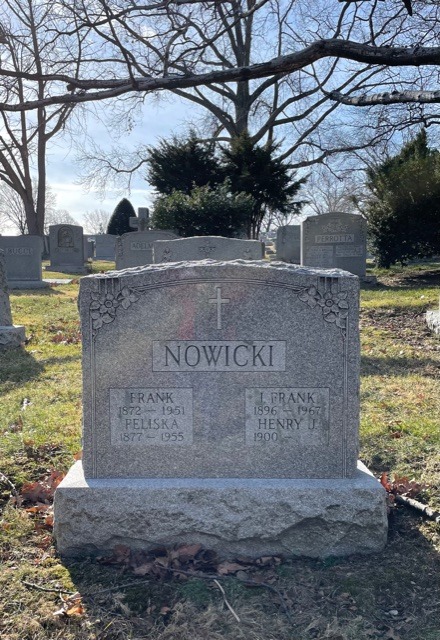
5 notes
·
View notes
Text
Woodlawn Cemetery has a new official website, you can access it here to see what projects they’ve been working on and get news about upcoming tours:
https://www.woodlawn.org/
2 notes
·
View notes
Photo
NOTE: I originally posted this blog several years ago. I have a few updates!
Here’s a better link to the article named above:
http://hatchingcatnyc.com/2013/12/06/new-yorks-public-christmas-tree/

The above photo of Emilie Herreshoff was taken in 1907. I found it in this Chicago Tribune online article, credited to the Herreshoff Marine Museum: https://www.chicagotribune.com/opinion/commentary/ct-opinion-flashback-first-christmas-tree-chicago-20191220-hawcuxxbizandbm2fmlyab3rni-story.html

Above photo via Library of Congress digital collection: https://www.loc.gov/resource/ggbain.11134/
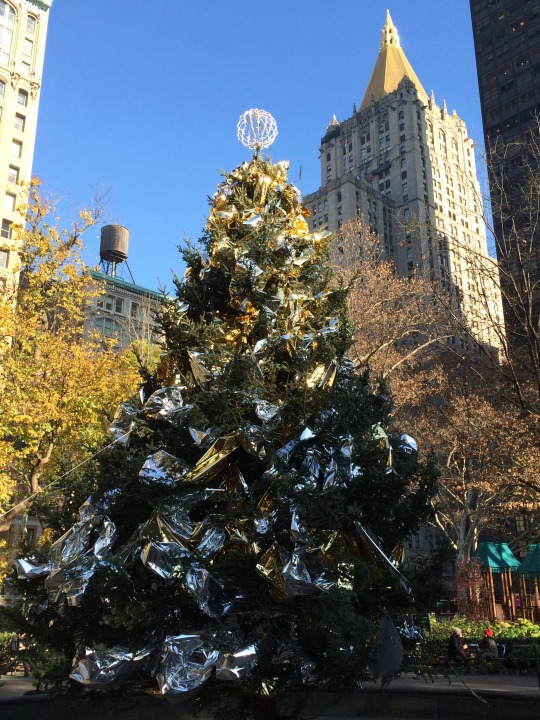
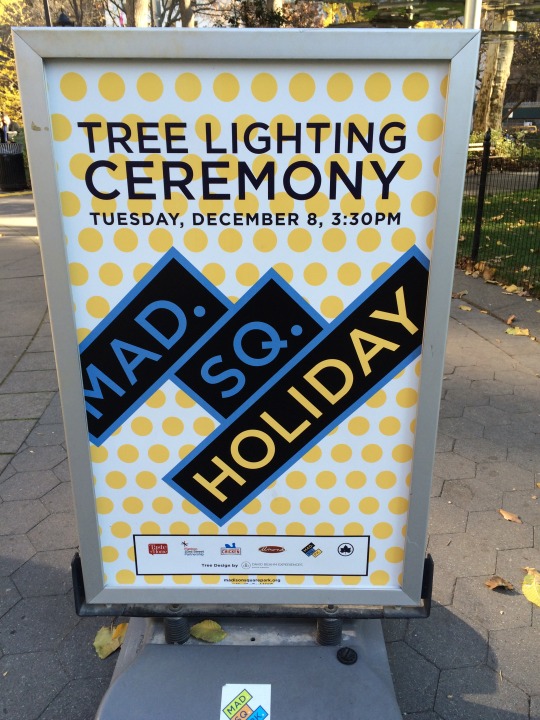
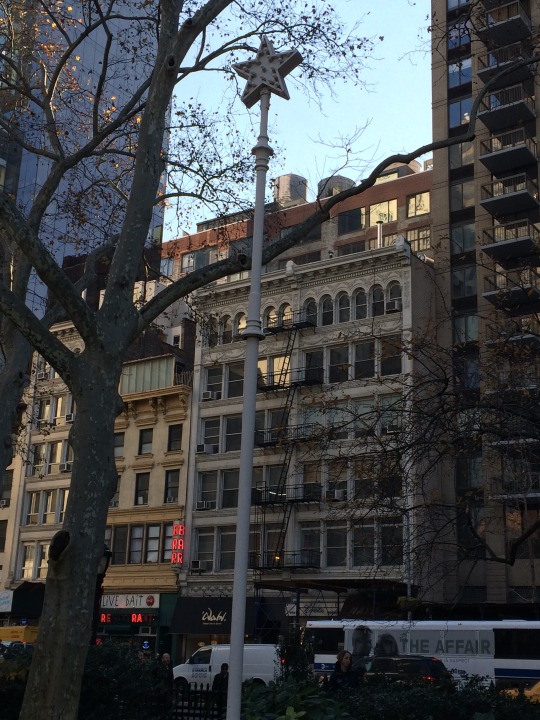
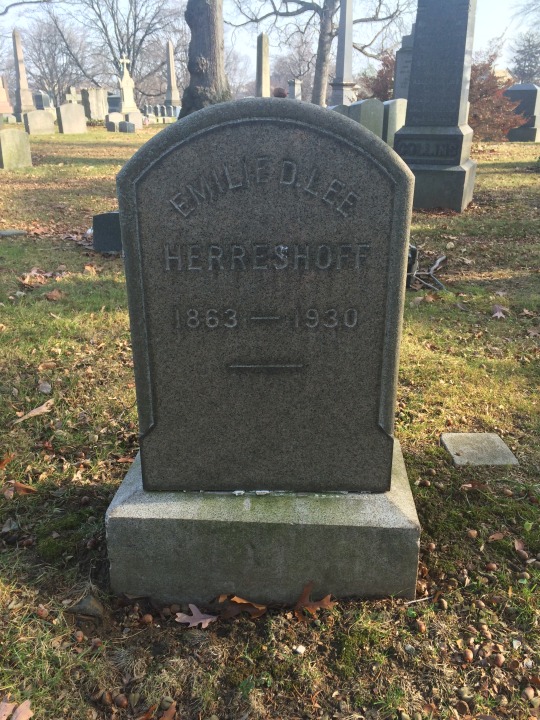
Christmas week post: Emilie Herreshoff & the first public Christmas tree
The very first public Christmas tree in the United States was erected in Manhattan in 1912, thanks to Emilie Duval Lee Herreshoff, who rests in Woodlawn Cemetery’s Catalpa section.
Emilie Herreshoff was the socialite wife of noted chemist Dr. John B.F. Herreshoff at the turn of the 20th century (they were later divorced.) In 1911, Mrs. Herreshoff reached out to NYC’s mayor William Jay Gaynor with the idea of putting up a community Christmas tree in an outdoor spot so that all New Yorkers, not just the wealthy ones, would be able to enjoy it. Her proposal was initially denied, but Emilie kept at it, and in 1912 her request was granted and plans were set in motion.
Madison Square in Manhattan was chosen as the site for the tree, which came to be referred to as “The Tree of Light.” The Adirondack League Club donated what was said to be their finest tree, a 60+ foot Balsam, and an anonymous railroad baron donated the services of a train to bring the tree from the upstate Adirondacks down to the city. The tree was erected by teamsters and lit by the Edison Company with over 1,200 multicolored bulbs strung on 6,000 feet of wire. A Star of Bethlehem topped the tree.
The New York Times wrote several gushing articles about the “Tree of Light” and the lighting ceremony which took place on Christmas Eve, December 24, 1912, free and open to the public. Church bells rang all over NYC’s boroughs that evening, some lasting 30 minutes, to signal the beginning of the ceremony. Thousands of people showed up in Madison Square during the course of the event which lasted from 5 30 p.m. until midnight. By some accounts it was Emilie Herreshoff herself who threw the switch that lit up the tree. The tree lighting was followed by a lengthy program of musical performances from various singers and choirs from around the city, singing traditional Christmas music from several different countries including England, France, Russia, Austria and Germany.
The “Tree of Light” remained in Madison Square from December 24 until January 1st and was so popular that it became not only an annual tradition in Madison Square but started a trend for public Christmas trees that would spread throughout the entire United States. In 1916 a 5-pointed star on a 35 foot high pole was erected in Madison Square to commemorate that first community Christmas tree. The “Star of Hope” monument still stands today at the 23rd Street side of Madison Square Park.
Although the Christmas tree at Rockefeller Center gets the most attention in the present day, Madison Square still has an annual Christmas tree lighting ceremony! Their most recent tree can be seen in my pictures above, along with the “Star of Hope” monument. The beautiful old building with the golden spire that can be seen in the background behind the Christmas tree is the New York Life Building.
All photos above are mine.
(much of the information for this post was gleaned from NY Times articles, as well as from a blog called The Hatching Cat which has some pictures of Madison Square Park’s first tree; there’s a link to that below:)
http://hatchingcatnyc.com/tag/emilie-d-lee-herreshoff/
6 notes
·
View notes
Text
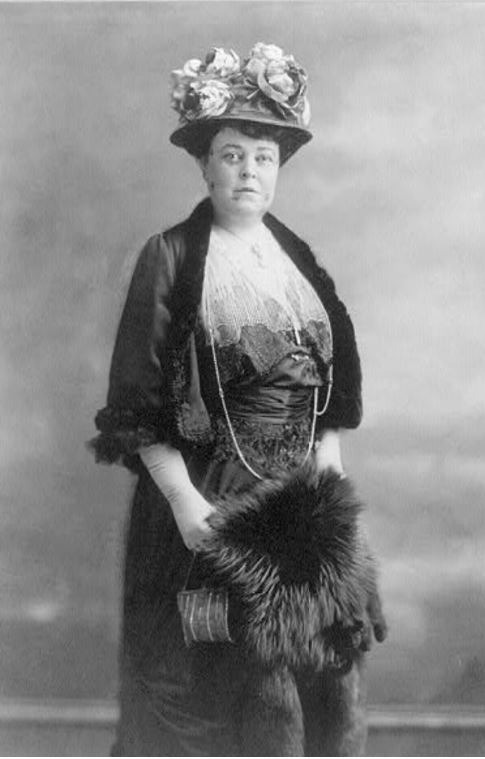
On Election Day 2020, Woodlawn Cemetery celebrated “Woodlawn Women Who Made a Difference”; they gave out a map to guide you around the cemetery to visit Woodlawn women who were important to the suffrage movement, including Alva Erskine Smith Vanderbilt Belmont, pictured above (via Library of Congress, https://www.loc.gov/item/2017647280/)
Mrs. Belmont and her banker/politician husband Oliver Hazard Perry Belmont rest in this magnificent Woodlawn mausoleum; Alva hired architects Hunt and Hunt to design it as a nearly exact replica of the Chapel of Saint Hubert in France. My photo doesn’t do it justice!
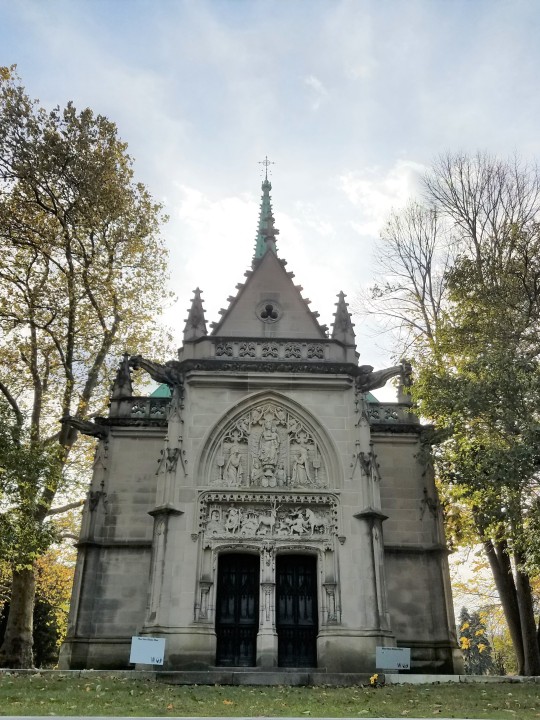
Alva was born into a monied family and married extremely well--twice! Her first husband was William Kissam Vanderbilt (grandson of “The Commodore” Cornelius Vanderbilt.) Vanderbilt was a philanderer who Alva scandalously divorced in 1895 (high society divorces being pretty rare at that time.) Her second husband was O.H.P. Belmont; they remained together until his death in 1908.
The widow Belmont first became interested in the Women’s Suffrage movement through her daughter Consuelo (then the Duchess of Marlborough by marriage to the English duke Charles Spencer-Churchill.) Consuelo told Alva about the women in England fiercely fighting for their right to vote.
In 1909, Alva began her involvement in the cause, hosting a party for 500 in her Newport, Rhode Island mansion that raised a large sum for the National Suffrage Association.
Alva’s influence with the wealthy and powerful led to the Association being moved from Ohio to New York; she rented and furnished the office space at 505 Fifth Avenue (now demolished.)
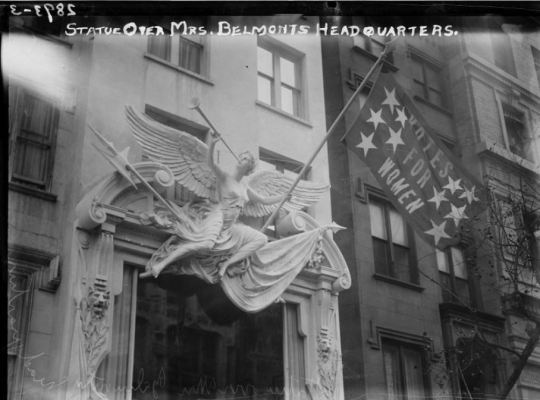
Above photo from Library of Congress: https://www.loc.gov/item/2014694697/
Alva fully committed to the cause, making speeches, walking picket lines, writing articles, passing out leaftlets, organizing soup kitchens and opening houses for suffragettes. Her Madison Avenue home was opened for meetings and lectures.
In May 1912, Alva marched in a suffragette parade up Fifth Avenue to Carnegie Hall for a rally.
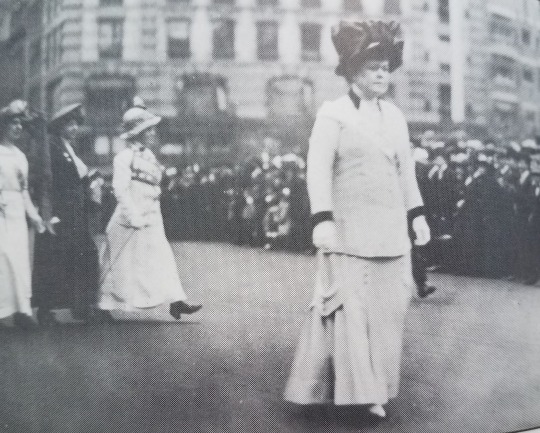
(Alva marching in the parade. Photo by Brown Brothers, from Margaret Hayden Rector’s biography Alva, That Vanderbilt-Belmont Woman.)
In July of 1914 Mrs. Belmont organized a “Conference of Great Women” at her Newport, Rhode Island mansion, with money raised going towards the cause. Actress Katherine Hepburn’s mother (also named Katherine Hepburn) attended that conference; she was a noted suffragette herself.
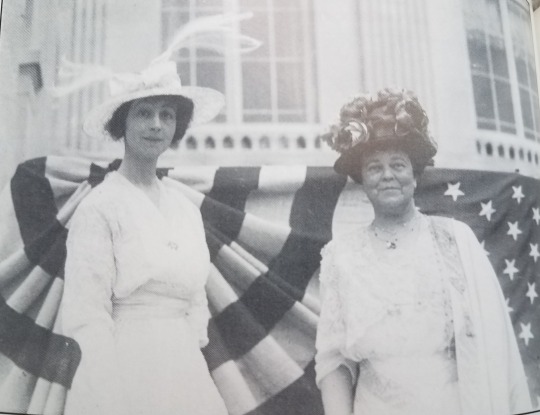
(above photo shows Alva on the right, with her daughter Consuelo at the Conference of Great Women. Consuelo was Guest of Honor at the conference. Photo by Brown Brothers, from Margaret Hayden Rector’s biography Alva, That Vanderbilt-Belmont Woman.)
The conference was so successful that Alva held a similar gathering at the mansion one month later.
Alva was the founder of the Political Equality Association and served on the board of the National Women’s Party. The National Women’s Party marched and picketed the White House; similar to the English suffragettes some members clashed with police and were jailed and force-fed.
When women’s legal right to vote was established in the U.S. in 1920, Alva was part of the celebration at National Headquarters in Washington D.C.
Thanks to Mrs. Belmont’s generosity, a new National Women’s Party headquarters was opened in D.C. in 1929, after she purchased the Sewall House for $100,000 cash. The headquarters still stands. President Barack Obama designated the Sewall–Belmont House a National Monument on April 12, 2016.
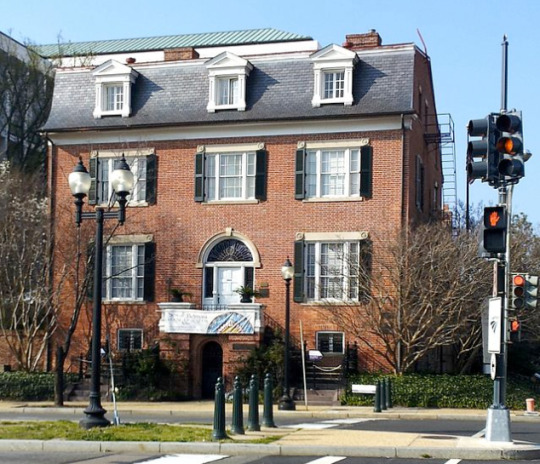
The house, renamed Belmont–Paul Women's Equality National Monument after Alva Belmont and Alice Paul, will continue to house the National Woman's Party collection, which includes an extensive library on women's suffrage and women's issues, the NWP archive, and museum holdings such as art, memorabilia, and exhibits. (above photo and excerpt from the informative Wiki page on the Belmont-Sewall House: https://en.wikipedia.org/wiki/Belmont%E2%80%93Paul_Women%27s_Equality_National_Monument)
2 notes
·
View notes
Text
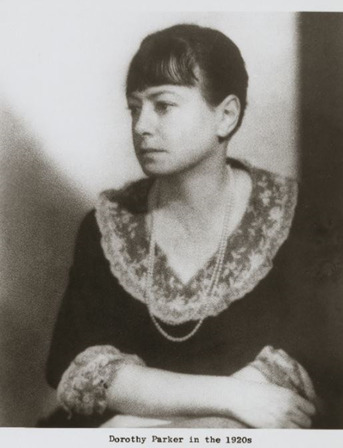
(above photo from NYPL Digital Collections: https://digitalcollections.nypl.org/items/510d47df-34d2-a3d9-e040-e00a18064a99)
Famed writer and Algonquin Roundtable wit Dorothy Parker has come to rest with her parents at Woodlawn Cemetery---after several DECADES!
A few years back, when I was working on Woodlawn Cemetery’s old foundation orders, I came across one from 1916 for Jacob Henry Rothschild, signed by his four children, including Dorothy Rothschild. I got really excited when I realized that Dorothy Rothschild was Dorothy Parker, a writer I’d become obsessed with years ago when I worked at Conde Nast (Parker had written for Vanity Fair, Vogue, The New Yorker and others.) Dorothy still had her maiden name in 1916; she wouldn’t become “Mrs. Parker” until her first marriage one year later.
What a thrill to see her name on that foundation order! At the time, I reached out to Woodlawn’s historian Susan Olsen about it and she told me that yes, Dorothy’s parents both rested here at Woodlawn (as well as her maternal grandparents) but Dorothy did not. At the time I spoke to Susan Olsen, Dorothy’s cremains were interred on the site of the NAACP in Baltimore, MD. Parker had believed deeply in the civil rights movement and upon her death in 1967 had bequeathed her estate to Dr. Martin Luther King Jr. (which surprised him since he had never met her!) After Dr. King’s assassination, Parker’s estate was transferred to the NAACP; they retain her book rights to this day. Incredibly enough, before the NAACP took possession of Dorothy’s cremains they had sat forgotten in her lawyer’s office for many years.
When the NAACP announced a few years ago that they were moving their Baltimore headquarters and Dorothy’s remains would have to move as well, her journey to Woodlawn Cemetery began.
You can read the full story here via the website of Dorothy Parker’s long-time fan and advocate, Kevin Fitzpatrick, who has written several books about her and runs the excellent official website, Dorothy Parker Society. It’s largely due to Kevin’s dedication that Dorothy now rests besides her parents. His page provides a link to the New Yorker magazine article that first broke the story of Dorothy Parker’s reburial at Woodlawn Cemetery; the article written by Laurie Gwen Shapiro relates more about Dorothy Parker, her connection to the NAACP and her journey to Woodlawn: ’https://dorothyparker.com/2020/09/homecoming.html
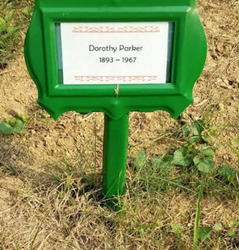
Above is a photo I took of Dorothy Parker’s temporary grave marker at Woodlawn; there will be a big ceremony (hopefully sometime next year) when her permanent marker is placed.
There’s no better person than Kevin Fitzpatrick to tell you who Dorothy Parker was and her deep connection to New York City, so here’s the link to the front page of his site if you’d like to read more about her.
https://dorothyparker.com/about
And just for the heck of it, here’s an undated and unmarked photograph that the New York Public Library has in their collection of Dorothy Parker with two pooches, via their Digital Collections: https://digitalcollections.nypl.org/items/510d47df-34d1-a3d9-e040-e00a18064a99 Kevin Fitzpatrick has written on his site about the photograph, saying it’s the only color photo of Dorothy Parker known to exist. It’s possible (but Fitzpatrick is not completely sure) that the photo was taken in her New York apt. and it’s probable but not certain that these were both Dorothy’s dogs. A mystery!
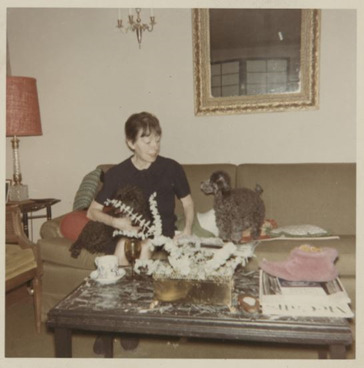
7 notes
·
View notes
Photo

A Bronx boy made good, musician and music producer Felix Pappalardi is best known as bass guitarist and co-vocalist for the band “Mountain”; they had their biggest hit with the song “Mississippi Queen.” It’s been played a gazillion times on the radio over the years; here’s a link if you’d like to listen to it now: https://www.youtube.com/watch?v=qFhM1XZsh6o
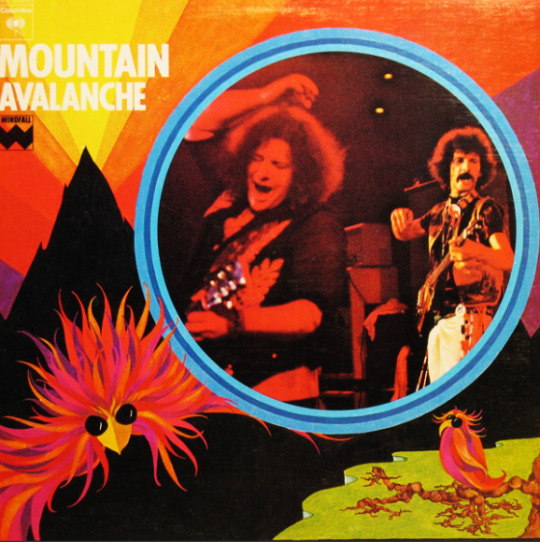
(this album cover shows Pappalardi on the right, with Mountain co-founder Leslie West on the left)
Mountain played at Woodstock on the second day of the festival (August 16, 1969); it was only their 4th ever gig--not a bad start!!
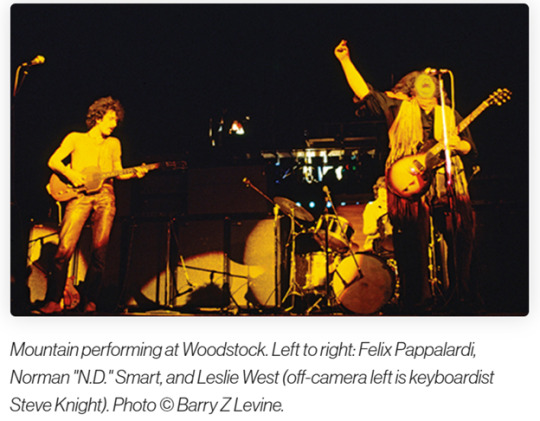
Above photo from the website: https://www.bethelwoodscenter.org/blog/mountain
Pappalardi was a music producer before he joined Mountain (and he continued to do it for the rest of his career); most notably he produced several of the band Cream’s albums and co-wrote the song “Strange Brew” with Eric Clapton and Gail Collins.
Gail Collins was Felix’s wife; their marriage came to a shocking end when Gail shot Felix to death early on the morning of April 17, 1983 (rumored to be during an argument over his intention to leave her for another woman.) She claimed the gun accidentally went off and gave conflicting stories; a jury found her of guilty of criminally negligent homicide and she served less than two years of a four year sentence. Felix Pappalardi was 43 years old when he was killed; he’s buried in Woodlawn’s Cliff section next to his mother.

(above is my own photo)
Pappalardi’s bandmates and others discuss Gail Collins’ murder trial here if you’re interested in more details about the case:
https://www.loudersound.com/features/felix-pappalardi-meets-a-tragic-end
Here’s a link to a good website created by a superfan of Felix Pappalardi; he owns some of Pappalardi’s personal items and shares his memories of him as well as photographs of the man and his guitars: http://www.experiencewoodstock.com/Felix-Pappalardi.html (note: I wouldn’t recommend clicking on the link for the Pappalardi tribute website he references on his page, “pappalardi-dot-com”-- it gave me a bad result. Not sure it’s a proper link so steer clear.)
More biographical info about Pappalardi can be found on his Wiki page; it also has a handy list of his music and producing credits: https://en.wikipedia.org/wiki/Felix_Pappalardi
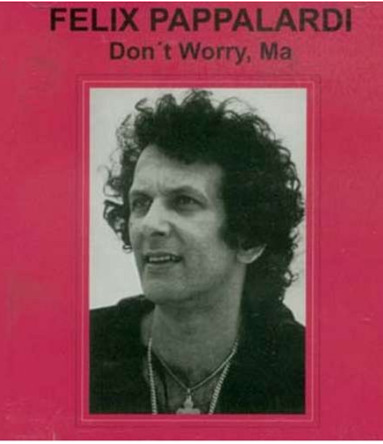
Felix Pappalardi had a couple of solo albums including one called “Don’t Worry Ma”; you can find it on Youtube. Here’s his funk version of “Sunshine of Your Love” off that album; I really like it!
https://www.youtube.com/watch?v=ZW25iewUfGY
2 notes
·
View notes
Photo
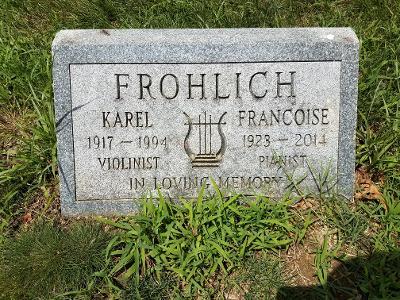
During a recent walk through Woodlawn Cemetery I came across this stone and immediately had to research Karel and Francoise Frohlich.
The New York Public Radio station WNYC has a page about the Frohlichs on their website along with an archived performance from 1948; it includes this photograph and some biographical information, excerpted below:
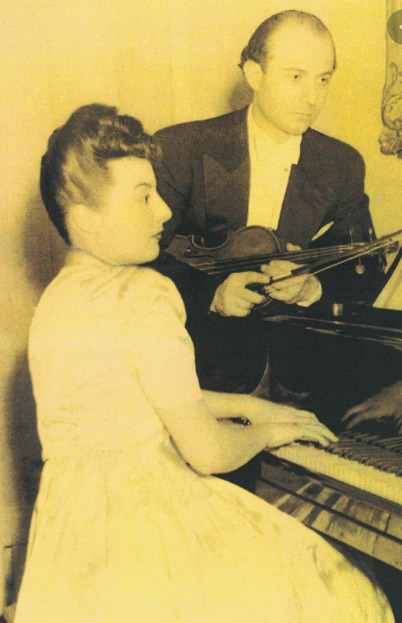
Karel Frohlich (1917-1994) on violin and Francoise Dupuy-Frohlich (1923-2014) on piano.
The couple gave joint recitals in Europe before coming to the United States. Francoise Dupuy-Frohlich previously lived in Paris and was a graduate of the Ecole Normale de Paris and studied with Alfred Cortot. She was also a member of several well-known music ensembles in Europe.
Karel Frohlich was a native of Czechoslovakia and graduate of Prague's National Music Conservatory. He played with the Prague Grand Opera Orchestra as Concert Master and appeared on the concert stage in France, Belgium, Czechoslovakia and Switzerland. He was the only member of his immediate and extended family in Europe to survive the Holocaust. He had been in Terezin, Auschwitz, and Buchenwald concentration camps.
At the time of this broadcast Frohlich was performing with the Little Orchestra Society of New York and serving as a member of the faculty at the City College of New York and the Turtle Bay Musical School.
Karel Frohlich and Francoise Dupuy-Frohlich were married for nearly 50 years and had four children. After performing extensively in New York City, Karel went on to a successful business career. Francoise was a piano teacher in New York City for 30 years and gave local recitals until 2003.
You can listen to their archived performance at the WNYC website here: https://www.wnyc.org/story/karel-frohlich-violin-francois-dupre-piano/
The Frohlich’s grandson wrote a testimonial about his grandfather’s experiences during the Holocaust of World War II (http://www.wingsofwitness.org/student%20memorials.htm#Courtney%20Memorial)
It includes this sobering 1948 newspaper article about Frohlich in which he relates that his violin playing was the only thing that saved his life in the concentration camps:
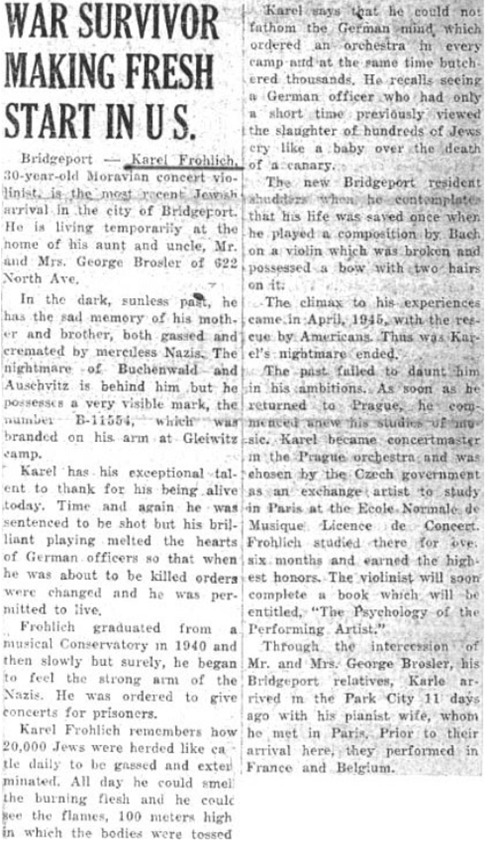
6 notes
·
View notes
Photo
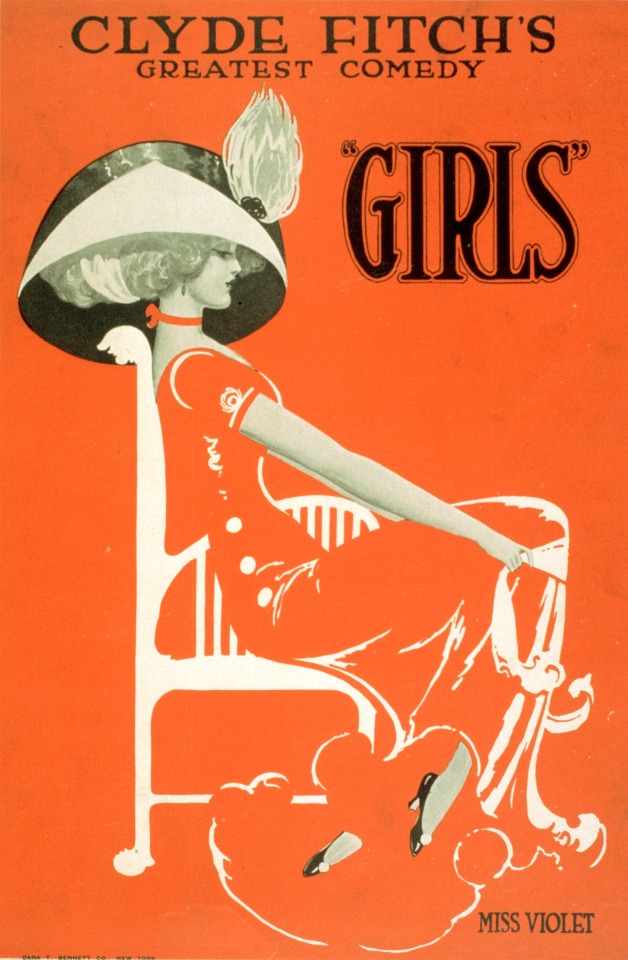

Happy Gay Pride Weekend!
Around the turn of the 20th century, Clyde Fitch was the most popular playwright on Broadway. At one point, he had an unheard of five shows running at the same time! Fitch suffered from ill health for most of his life and was only 44 when he died in France in 1909; he rests in Woodlawn Cemetery’s Wintergreen plot.
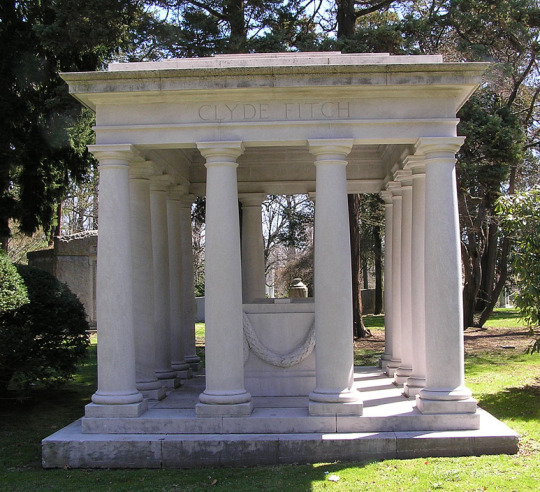
The never-married Fitch was known as a “dandy” in his day and going by his written correspondence it’s probable he had a brief affair with Oscar Wilde. He was also good (platonic) friends with Edith Wharton. His literary agent was lesbian Elisabeth Marbury who openly lived for decades with her partner Elsie DeWolfe.
Elisabeth Marbury also rests in Woodlawn; I’ve blogged about her before: https://lost-in-woodlawn.tumblr.com/post/162243799522/happy-pride-weekend-elisabeth-bessy-marbury

Fitch in his study in Connecticut; photo via NYPL Digital Collections https://digitalcollections.nypl.org/items/510d47d9-b980-a3d9-e040-e00a18064a99
The above poster for Fitch’s play “Girls” and the photo of the beautiful Woodlawn mausoleum Fitch’s mother had designed for him were found at his Wiki page where you can find more biographical info as well as links to other reference pages.
https://en.wikipedia.org/wiki/Clyde_Fitch
The website NYC LGBT Historic Sites Project has a page referencing Clyde Fitch and other LGBT people who rest in Woodlawn Cemetery; you can see it here: https://www.nyclgbtsites.org/site/woodlawn-cemetery/
5 notes
·
View notes
